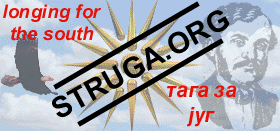
 |
Vevchani Carnival 2005 (Part 2) |
Although it’s been linked for many centuries to the Orthodox (Julian Calendar) New Year’s holiday, the Vevchani Carnival like many others has its roots in the pagan tradition. Along with alleviating winter doldrums, the carnival also offered its participants the chance to drive away evil spirits. The symbolic exodus of such harmful apparitions was conducted through ritual burnings, and raucous immolation is still central to the modern Vevchani Carnival.
In this light, we can understand how the carnival allows the people to cleanse themselves of evil political spirits as well, mocking through their costumes everything that Macedonians usually just fatalistically grumble over. Now that every pool in Macedonia has been closed, and sports teams forced to travel to neighboring countries to train, the arrival of a mock water polo team cavorting up by the fountain became a pointed message.
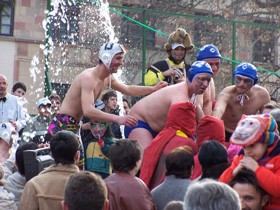 Suited-up water polo players and Tetovo University “medical students” lightened the mood but underscored important political points as well. 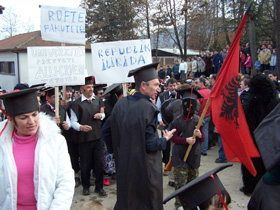
|
Similarly, the endless agitations of the unlicensed Tetovo University “medical students” was mocked by a group of improvised Albanian nationalists sporting graduation caps, Albanian flags and “Republic of Ilyrida” signs. Led by a “rector” who merrily signed diplomas for anyone who asked, the performance made light of a situation that is quite serious for Macedonians concerned with declining standards and the destructive influence of Kosovo Albanians on their country. For an afternoon at least, people could sit back and laugh.
This view was seconded by one longtime carnival observer. “We don’t know about our political future,” said 50 year-old Vlade, a local resident. “That is in the hands of the West. But the carnival at least gives us a chance to have fun and relax.”
Politics enters the carnival every year. Osama bin Laden has made an appearance, as have many world leaders. This year, George W. Bush could be seen lurking about with a rather grim masked commando (not an unreasonable comrade, all things considered).
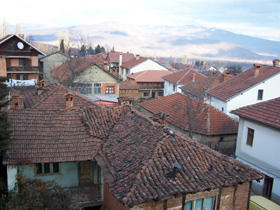 The idyllic village of Vevchani is situated north of Struga, in the folds of Mt. Jablanica. |
Although Macedonia has several winter carnivals, Vevchani’s is the best. This owes partially to its long tradition, but also to the proud, peculiar nature of the locals. Unlike many Macedonian villages, Vevchani is well maintained and well populated, with stone streets and houses and a population of around 2,500. Everywhere throughout the village one can hear the sound of rushing water, as the tiny gutters running parallel down sloping streets carry crystal-clear water down from the mountains. Vevchani is famous for its springs, which visitors can explore along lit wooden walkways traversing the lush forests above the village. In 1987 the villagers showed their spirited dedication to their springs by forcing the Yugoslav authorities to desist from their plans to divert their flow to Struga.
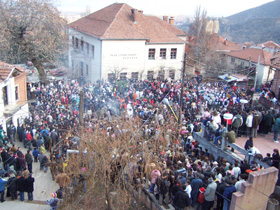 The throngs gather to watch the procession disintegrate on Friday afternoon. |
Vevchani’s famous stubbornness and insularity was most famously displayed, however, by the decision to break away and create an independent republic at the time when Macedonian declared its own independence in 1991. The announcement, driven by fear of encirclement by neighboring Albanian villages, was so offbeat that it attracted the brief worldwide attention. While the independence movement faltered, one can still acquire an official “Vevchani Republic” passport and colorful local currency (known as lichnitsi) from the municipal office. The wild illustrations on the money range from depictions of Mayor Vasil Radinoski (on the 1 lichnik note) to traditional houses, wine flasks, woodlands and St. Basil, as well as naked women (on the 1000 lichnik note) – an eloquent expression of carnival priorities.
After bulldozing its way through the main square, Thursday’s main carnival procession clambered up Vevchani’s steep streets in a disorganized circuitous route, while the crowd milled back to their homes for heavy eating and drinking. Mayor Radinoski led his own delegation to the village’s traditionally-decorated restaurant, which was overflowing with revelers under the influence of pork and wine, all the while being regaled by singers with violins and guitar.
After the carnival procession had made its circle around the village, supported by donations of wine from houses they passed by on the way, a brief pause was enjoyed before the evening’s festivities – drinking and dancing in the school playground. Costumed characters in various states of undress mingled with onlookers as a live band belted out Macedonian national songs.
Thursday night dissolved into more dance and drinking in Vevchani’s bars, cafés and homes, while costumed children counted the pocket money they’d taken in (almost like Halloween) from their sojourns around the village. When Friday broke, some participants were still alive and ruddy but many others were weary and dead. Dead drunk, that is.
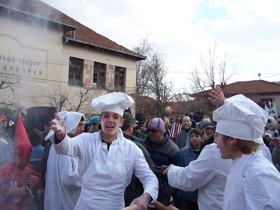 The Vevchani bakers. Just moments after this photo was taken, their rolling oven was burned to the ground. |
Although the general merriment would last throughout the evening, the carnival staggered to a close late Friday afternoon, as the by now rather disheveled procession rallied ferociously in the square, led by the incessant horns and drums, only to fall apart in dizzying, burning circles of smoking ash and wind-borne flour. The baker’s oven itself finally went up in flames, fork-tailed demons dragged a helpless captive over the roasting coals, ancient Macedonian warriors in armor clasped arms with modern-day Albanian freedom fighters, and a crowd of about 1,000 looked on in bemusement and inebriation. Yes, another year of the carnival in Vevchani.
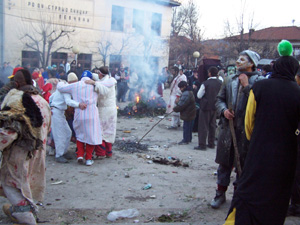 Dazed participants stagger and regroup amidst the final scenes of carnage. |